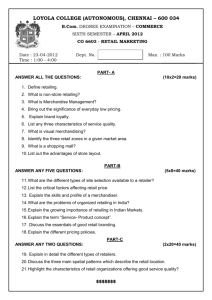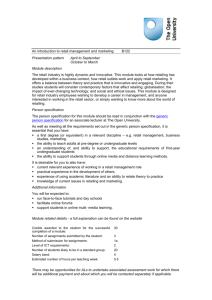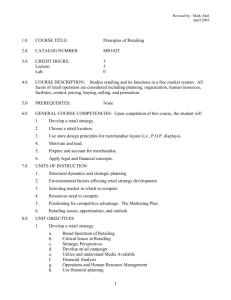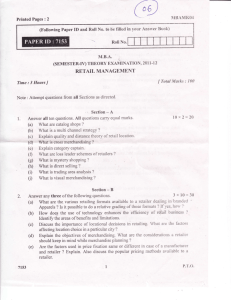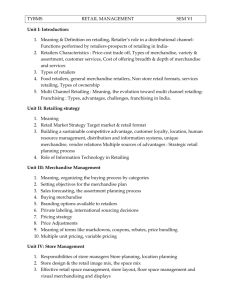- UMT Admin Panel
advertisement
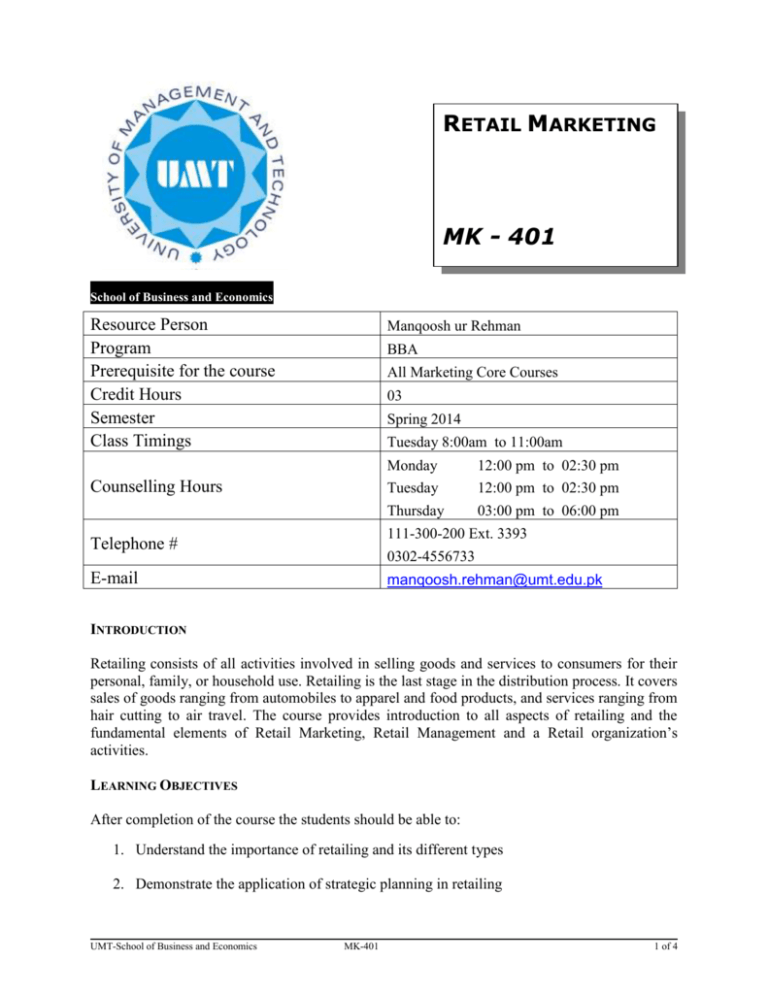
RETAIL MARKETING MK - 401 School of Business and Economics Resource Person Program Prerequisite for the course Credit Hours Semester Class Timings Manqoosh ur Rehman BBA All Marketing Core Courses 03 Spring 2014 Tuesday 8:00am to 11:00am Counselling Hours Monday Tuesday Thursday 12:00 pm to 02:30 pm 12:00 pm to 02:30 pm 03:00 pm to 06:00 pm Telephone # 111-300-200 Ext. 3393 0302-4556733 E-mail manqoosh.rehman@umt.edu.pk INTRODUCTION Retailing consists of all activities involved in selling goods and services to consumers for their personal, family, or household use. Retailing is the last stage in the distribution process. It covers sales of goods ranging from automobiles to apparel and food products, and services ranging from hair cutting to air travel. The course provides introduction to all aspects of retailing and the fundamental elements of Retail Marketing, Retail Management and a Retail organization’s activities. LEARNING OBJECTIVES After completion of the course the students should be able to: 1. Understand the importance of retailing and its different types 2. Demonstrate the application of strategic planning in retailing UMT-School of Business and Economics MK-401 1 of 4 3. Differentiate between different models of retail competition 4. Understand the retailer’s marketing mix policies and legislative constraints thereof 5. Understand the operational issues involved in retailing 6. Understand the various factors and attributes to be considered in evaluating the retail sites 7. Understand the elements of store environment and its objectives 8. Identify various types of fixtures, merchandise presentation methods and techniques to be used to increase the productivity of the sales floor 9. Understand the role of visual communications in a retail store 10. Understand the importance of a merchandise budget and know haw to prepare a merchandise plan LEARNING METHODOLOGY Apart from the lectures on book chapters, this course will also include a fair number of case studies from Pakistan’s retail sector. Discussions on these cases will be stimulated and invited to understand and solve the unique issues associated with retail marketing. The case studies and their related material will be available on Moodle. Participants are expected to read and comprehend the material, prepare the case study and discuss it in small study groups before coming to the class. Participants are expected to not only attend all classes but also fully participate in discussions in a meaningful and productive manner. Plagiarism is severely punished as per university policy. Participants are advised to refrain from copying or claiming credit for anything which is not their own. The same applies to internet downloads. All sources of data or text must be acknowledged properly. TERM PROJECT The term project for this course is to select a well known national or local retail brand and study the following for that retail brand. 1. 2. 3. 4. 5. 6. 7. 8. 9. History Objectives Type of Ownership Retail Format Retail Image Mix Displays Space Mix Merchandising Supply Chain Process UMT-School of Business and Economics MK-401 2 of 4 10. Retail Marketing Strategies 11. Research 12. Customer Service 13. Future Outlook Students will form teams of 3 members each to work on this project. Every team must choose a different retail store. The retail store you choose must be approved by the resource person. The retail stores will be assigned to teams on first come first served basis. The guidelines about how to write the report on above project will be provided to the participants separately. To complete the requirements for completing, the participants are expected to: 1. Prepare and submit the report before the end-term exam 2. Make a formal presentation. GRADING SYSTEM Quizzes 10 % Assignments 10 % Class Participation 05 % Case Analysis & Presentation 10 % Mid Term Retail Activity 15 % Project 15 % Total Sessional Evaluation 65 % Final Exam 35 % Total 100 % RECOMMENDED TEXT BOOK 1. Retail Management: A strategic approach, 11th Edition, Barry Berman and Joel R. Evans, Mini Mathur, Pearson REFERENCE BOOKS 1. Retailing Management, 7th Edition, Michael Levy & Barton A. Weitz 2. Retailing, 5th Edition, Patrick M. Dunne & Robert F. Lusch 3. Retailing: An Introduction, 5th edition, Roger Cox, Paul Brittain UMT-School of Business and Economics MK-401 3 of 4 CALENDAR OF ACTIVITIES Week 1 Topic Introduction Retailing and Case Overview of Reading - Chapter 1 & 2 - Liberty Books Relationships in Retailing 2 Strategic Planning in Retailing 3 Types of Retail Institutions 4 Non Traditional Retailing 5 Identifying Customers and Best Buy in a Global Growth Mode - Chapter 3 - Chapter 4 & 5 - Ideas by Gul Ahmed Understanding - Chapter 6 - Chapter 7 - Chen One 6 Information Gathering & Processing Retailing Lessons from - Chapter 8 in Retailing Loyalty Programs Around the Globe 7 Trading Area Analysis 8 Site Selection - Chapter 9 Tough Times for Shopping - Chapter 10 Centers - Chapter 1 to 10 MID TERM EXAM 9 HRM Issues in Retail Organization - Chapter 11 & 13 Operational Issues of Retailing - English House 10 Financial Dimensions Organizations of Retail Financial Merchandise Management 11 Merchandise Developing and Merchandise Plans Management: Implementing 12 Pricing in Retailing 13 Retail Image Management Boot - Chapter 12 - Chapter 16 - Chapter 14 & 15 - Khaadi Lowe’s: Category Potential - Chapter 17 Among Female Shoppers - Chapter 18 - Amir Adnan 14 Promotion in Retailing 15 Integration and Control of Retail Strategy UMT-School of Business and Economics Crossing the Great Media - Chapter 19 Channel Divide MK-401 - Chapter 20 4 of 4
